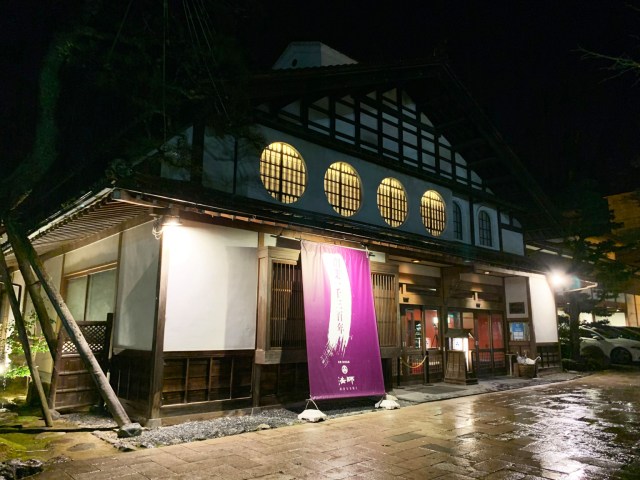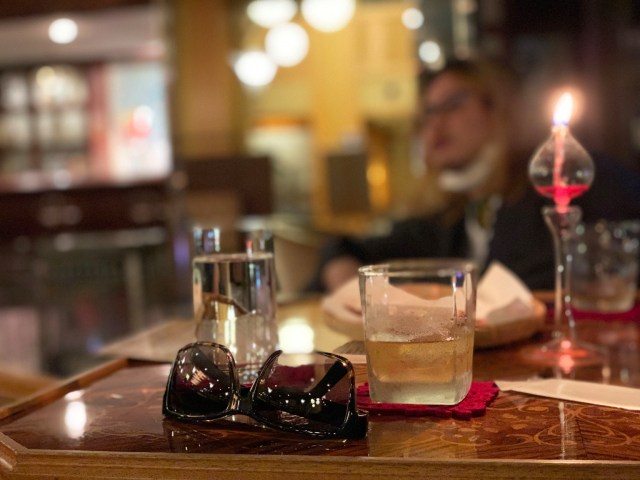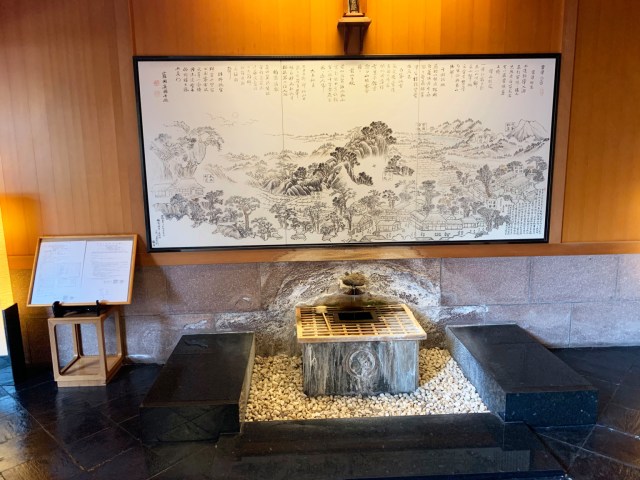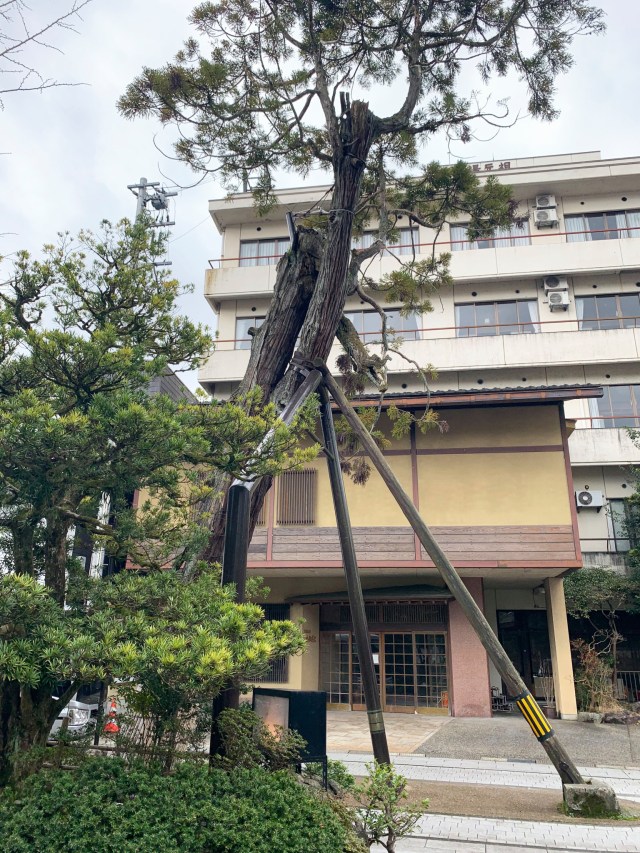
Japanese onsen ryokan adapts to the new normal after being in business for over 1,300 years.
Japan is home to a large number of long-established businesses, including two of the oldest hotels in the world: Yamanashi Prefecture’s Keiunkan and Ishikawa’s Houshi Ryokan.
Houshi Ryokan held the Guinness World Record title for the world’s oldest hotel until 2011, when Keiunkan pipped it at the post, taking the title after its opening date of 705 was found to have preceded Houshi’s 718 founding by thirteen years.
▼ Houshi Ryokan is so old it’s even been depicted in paintings from the Edo Period (1603-1868).
While the two hotels have been accommodating guests–including luminaries like daimyo Takeda Shingen, shogun Tokugawa Ieyasu, and numerous emperors–for over 1,300 years, both are now sadly struggling due to the drop in visitors brought about by the coronavirus pandemic.
The hotels have since discounted their prices to help entice guests, which means people who couldn’t previously afford to pay the usual 30,000 yen (US$271.14) ballpark fee for a room can now fulfil their dreams of a stay and a soak in the historic hot spring waters. Our Japanese-language reporter Seiji Nakazawa is one of those people, and he didn’t waste any time in making a booking, choosing to head out to Houshi Ryokan for a night to remember.
▼ Arriving after sunset makes the legendary ryokan appear even more atmospheric.
Stepping into the lobby, Seiji was greeted by dark wood panels, paper-screen lanterns, and a high ceiling that exudes a sense of old-school luxury.
After checking in at the reception desk, Seiji looked around for a porter to help him carry his luggage to his room, a service often provided at luxury ryokan. However, the ryokan seemed to be operating with minimal staff, so when no one appeared, he enquired and was told that guests were now being asked to use the trolleys provided to take their own luggage to their rooms.
Seiji didn’t complain, because after paying 13,000 yen for his room, which came complete with two top-quality meals, he remembered he’d booked a “self-service stay” plan, which meant some of the luxury extras had been trimmed in exchange for the discount.
▼ So Seiji took a look at the signboard to familiarise himself with the layout of the building…
▼ And took the elevator up to his room.
▼ While admiring some of the fancy Egyptian-styled decor on the way.
Given that the price he’d paid to stay here for the night was roughly equivalent to what you’d pay for a night at a business hotel, Seiji wasn’t sure what to expect when he opened the door to his room. He needn’t have worried, though, because the space was bright, clean, and much bigger than what he’d expected.
He particularly loved the fact that it came with a hiroen, a Japanese-style enclosed verandah. Not all ryokan include rooms like this, which are designed so that guests can enjoy views of nature, and this one was extra special because…
It comes with a sunken kotatsu known as a “hori-gotatsu“, which has a recessed floor underneath the low table, so you can sit at it like you would at a Western-style table.
Seiji felt as if he could happily sit here and stare out at the trees all evening, but that’s when he heard a voice calling to him from outside the door to his room. When he opened the door, he saw a member of staff greeting him with a smile…and a trolley full of food.
On a usual evening, staff would serve Seiji his meal in stages while he was seated at the table inside, but ever since the pandemic, staff are no longer allowed to enter guest rooms with guests. So the staff member apologised and asked Seiji if he wouldn’t mind serving himself with the food he’d brought, as part of the “self-service stay” plan.
Again, Seiji was more than happy to oblige with this self-service request, and it didn’t take him long to set up the table with everything he’d been given, as it was all pre-prepped and nicely arranged on plates.
The dinner plan included with his stay was dubbed a “bento” supper, but this was no ordinary bento, as it came with classy ingredients like sashimi, tempura, grilled fish, simmered dishes, and a beef shabu shabu hotpot.
Every dish was delicious and by the end of it all, Seiji actually preferred this self-service style of dinner. While it’s nice to be have your meal served to you by a friendly host, there’s sometimes a feeling of pressure to make light conversation and finish your dish by the time the server returns to the room. However, by serving himself, Seiji was able to enjoy a relaxed dinner without any interruptions.
▼ And to clean up, all you have to do is put your trays on the cart that’s been left in front of your room.
Then it was time to enjoy the natural hot springs, which the hotel was originally built around after they were discovered by a woodcutter and a monk who’d had a vision about the healing waters in the 700s.
▼ Then there was time for a nightcap at the bar before heading off to bed.
After a bissful night’s sleep, Seiji enjoyed a hearty self-service breakfast in his room and spent some time admiring the peaceful, natural scenery.
▼ He also made time for another soak in the ryokan’s healing waters.
As he walked around the hotel in the morning, he was able to appreciate the beautiful Japanese garden on the grounds.
This is where guests can catch a glimpse of the Enmeikaku VIP Hall, a lodge constructed using traditional joinery methods, without the use of a single nail. Located in the centre of the garden, Enmeikaku is a special wing of the hotel where VIP guests like Imperial Family members have stayed, and in 2016 it was designated a Registered Tangible Cultural Property of Japan.
Seiji spotted some interesting displays during his stroll, including this signboard, which details the minerals and health benefits of the hot spring waters…
…And this display of an old water spout, along with an Edo-period ink painting above the wall showing Houshi Ryokan as it used to look centuries ago.
▼ The slanted pine tree in the middle of the painting can still be seen on the grounds today.
Given the hotel’s incredibly long and esteemed history of treating guests to a taste of luxury, Seiji wanted to find out more about its decision to introduce the “self-service stay” plans and whether they’d been well-received by the public.
▼ So he spoke to Mr Saka, the manager of the ryokan, who was more than happy to answer his questions.
According to Mr Saka, the self-service plans started in 2020 to help put guests at ease during the growing pandemic, and while it came as a bit of a surprise to customers at first, and was even met with some controversy in local newspaper reports, it’s now become the norm.
Mr Saka says the self-service plans, which start at 8,000 yen, are set to continue for the time-being, as they’ve had an overwhelmingly positive response from guests, who’ve commented on how easy and comfortable it makes their stay.
The hotel is now thinking of continuing the plan as an option for guests even after the coronavirus outbreak eases, and Seiji himself thinks this is a great idea, as it allows guests to maintain control over how they use their time at the ryokan, taking all the stress out of their stay.
Here’s hoping the new self-service plans work to help the business through the current crisis, because after hearing about the sad closure of an Edo-period restaurant and the liquidation struggles of the prior owners of Keiunkan, there’s never been a more important time to help preserve the fragile history of Japan’s oldest businesses.
Ryokan information
Awazuonsen Houshi Ryokan / 粟津温泉 法師
Address: Ishikawa-ken, Komatsu, Awazumachi 46
石川県小松市粟津町ワ46
Website
Photos ©SoraNews24
● Want to hear about SoraNews24’s latest articles as soon as they’re published? Follow us on Facebook and Twitter!
[ Read in Japanese ]




























 We visit the Guinness World Record-holding oldest hotel in the world – established 705 A.D.!
We visit the Guinness World Record-holding oldest hotel in the world – established 705 A.D.! Prior owners of Keiunkan ryokan, the world’s oldest hotel, liquidate company
Prior owners of Keiunkan ryokan, the world’s oldest hotel, liquidate company The top five best multiple-hot-spring hotels in all of Japan
The top five best multiple-hot-spring hotels in all of Japan Japan’s 10 best ryokan inns and top 10 hotels, as chosen by foreign visitors
Japan’s 10 best ryokan inns and top 10 hotels, as chosen by foreign visitors Beautiful new Tokyo hotel gives you the best of both worlds with hot spring bath in the big city
Beautiful new Tokyo hotel gives you the best of both worlds with hot spring bath in the big city Ramen restaurant’s English menu prices are nearly double its Japanese ones, denies discriminating
Ramen restaurant’s English menu prices are nearly double its Japanese ones, denies discriminating What’s inside Starbucks Japan’s fukubukuro lucky bag for 2026?
What’s inside Starbucks Japan’s fukubukuro lucky bag for 2026? Dragon Quest Burgers and Slime drinks are coming to McDonald’s Japan【Video】
Dragon Quest Burgers and Slime drinks are coming to McDonald’s Japan【Video】 Our 52-year-old pole dancing reporter shares his tips for achieving your New Year’s exercise goal
Our 52-year-old pole dancing reporter shares his tips for achieving your New Year’s exercise goal Starbucks Japan releases new Frappuccino and latte for Valentine’s Day
Starbucks Japan releases new Frappuccino and latte for Valentine’s Day 10 times to avoid traveling in Japan in 2026
10 times to avoid traveling in Japan in 2026 Same character, different animator – Fans compile comparison charts for anime’s biggest stars
Same character, different animator – Fans compile comparison charts for anime’s biggest stars Part of the family – Tokyo Shinto shrine’s blessings for children now available for pets too
Part of the family – Tokyo Shinto shrine’s blessings for children now available for pets too A visit to the best UFO catcher arcade in the universe!
A visit to the best UFO catcher arcade in the universe! The meaning of the mandarin and 6 other Japanese New Year traditions explained
The meaning of the mandarin and 6 other Japanese New Year traditions explained Japanese beef bowl chain Sukiya’s 2026 Smile Box lucky bag basically pays for itself
Japanese beef bowl chain Sukiya’s 2026 Smile Box lucky bag basically pays for itself Top Japanese cosplayer Enako returns to Comiket after 6 years, creates mayhem with admirers
Top Japanese cosplayer Enako returns to Comiket after 6 years, creates mayhem with admirers Cup Noodle tries an authentic Jiro-style ramen, but something’s not quite right
Cup Noodle tries an authentic Jiro-style ramen, but something’s not quite right Hayao Miyazaki says Happy New Year to Studio Ghibli fans with new art for Year of the Horse
Hayao Miyazaki says Happy New Year to Studio Ghibli fans with new art for Year of the Horse Starbucks Japan ready to get Year of the Horse started with adorable drinkware and plushies【Pics】
Starbucks Japan ready to get Year of the Horse started with adorable drinkware and plushies【Pics】 Umamusume anime girl plushie recalled for having parts she absolutely should not have【Pics】
Umamusume anime girl plushie recalled for having parts she absolutely should not have【Pics】 We ate sushi made from Japan’s most expensive tuna ever【Taste test】
We ate sushi made from Japan’s most expensive tuna ever【Taste test】 7-Eleven Japan starts new temporary luggage storage service in over 300 branches
7-Eleven Japan starts new temporary luggage storage service in over 300 branches Disillusionment at Tsukiji’s tourist-target prices led us to a great ramen restaurant in Tokyo
Disillusionment at Tsukiji’s tourist-target prices led us to a great ramen restaurant in Tokyo Starbucks teams up with 166-year-old Kyoto doll maker for Year of the Horse decorations【Photos】
Starbucks teams up with 166-year-old Kyoto doll maker for Year of the Horse decorations【Photos】 Tokyo’s Tsukiji sushi neighborhood asks tour groups to stay away for the rest of the month
Tokyo’s Tsukiji sushi neighborhood asks tour groups to stay away for the rest of the month Japan may add Japanese language proficiency, lifestyle classes to permanent foreign resident requirements
Japan may add Japanese language proficiency, lifestyle classes to permanent foreign resident requirements Lacquerware supplier to emperor of Japan and Pokémon team up for new tableware
Lacquerware supplier to emperor of Japan and Pokémon team up for new tableware Starbucks Japan releases new zodiac chilled cup drink for 2026
Starbucks Japan releases new zodiac chilled cup drink for 2026 Tokyo considering law requiring more trash cans following litter increase in heavily touristed area
Tokyo considering law requiring more trash cans following litter increase in heavily touristed area Survey asks foreign tourists what bothered them in Japan, more than half gave same answer
Survey asks foreign tourists what bothered them in Japan, more than half gave same answer Japan’s human washing machines will go on sale to general public, demos to be held in Tokyo
Japan’s human washing machines will go on sale to general public, demos to be held in Tokyo We deeply regret going into this tunnel on our walk in the mountains of Japan
We deeply regret going into this tunnel on our walk in the mountains of Japan Studio Ghibli releases Kodama forest spirits from Princess Mononoke to light up your home
Studio Ghibli releases Kodama forest spirits from Princess Mononoke to light up your home Major Japanese hotel chain says reservations via overseas booking sites may not be valid
Major Japanese hotel chain says reservations via overseas booking sites may not be valid Put sesame oil in your coffee? Japanese maker says it’s the best way to start your day【Taste test】
Put sesame oil in your coffee? Japanese maker says it’s the best way to start your day【Taste test】 No more using real katana for tourism activities, Japan’s National Police Agency says
No more using real katana for tourism activities, Japan’s National Police Agency says Starbucks Japan reveals new sakura drinkware collection, inspired by evening cherry blossoms
Starbucks Japan reveals new sakura drinkware collection, inspired by evening cherry blossoms Updated cherry blossom forecast shows extra-long sakura season for Japan this year
Updated cherry blossom forecast shows extra-long sakura season for Japan this year Human washing machine pods coming to Japanese hotels【Photos】
Human washing machine pods coming to Japanese hotels【Photos】 Low-cost Japanese inn welcomes foreign guests with hot springs, sake tastings, cosplay backdrops
Low-cost Japanese inn welcomes foreign guests with hot springs, sake tastings, cosplay backdrops Japanese-style accommodation at the new Premium Dormy Inn hotel in Asakusa will blow your mind
Japanese-style accommodation at the new Premium Dormy Inn hotel in Asakusa will blow your mind Hakone onsen ryokan offers crazy cheap “Gimme a flippin’ break from the coronavirus” room deals
Hakone onsen ryokan offers crazy cheap “Gimme a flippin’ break from the coronavirus” room deals Japanese love hotel makes plans to apply for Guinness World Record
Japanese love hotel makes plans to apply for Guinness World Record Japanese pot sticker restaurant chain also runs flat-rate hot spring inn, but is it worth staying at?
Japanese pot sticker restaurant chain also runs flat-rate hot spring inn, but is it worth staying at? “The best ryokan I’ve ever visited” – A photo tour of Akita Prefecture’s Miyakowasure inn
“The best ryokan I’ve ever visited” – A photo tour of Akita Prefecture’s Miyakowasure inn Beautiful, 100-year-old Japanese guest house is so cheap, for some guests it’s free
Beautiful, 100-year-old Japanese guest house is so cheap, for some guests it’s free Doll otaku’s plastic bedmate gets loving hospitality from beautiful Japanese hot spring inn
Doll otaku’s plastic bedmate gets loving hospitality from beautiful Japanese hot spring inn Japanese hot spring inn lets you spend night for under US$1 if you do something special in return
Japanese hot spring inn lets you spend night for under US$1 if you do something special in return Bad weather ruined your chance to see Mt. Fuji? This Japanese hotel will give you a free room
Bad weather ruined your chance to see Mt. Fuji? This Japanese hotel will give you a free room More than a capsule hotel, downtown Tokyo capsule ryokan is awesome, budget-friendly spot to stay
More than a capsule hotel, downtown Tokyo capsule ryokan is awesome, budget-friendly spot to stay A private onsen bath with a karaoke machine is two of Japan’s best things with zero embarrassment
A private onsen bath with a karaoke machine is two of Japan’s best things with zero embarrassment The top three ranking of hotel “poster cats” that Japanese travelers are most eager to meet
The top three ranking of hotel “poster cats” that Japanese travelers are most eager to meet Survey reveals the most popular time to slip into a yukata at a traditional Japanese inn
Survey reveals the most popular time to slip into a yukata at a traditional Japanese inn The 10 best hotel hot springs in Japan, as chosen by Japanese travelers
The 10 best hotel hot springs in Japan, as chosen by Japanese travelers
Leave a Reply